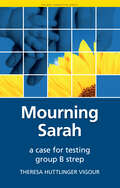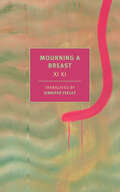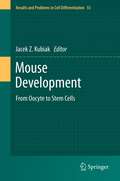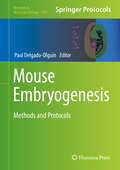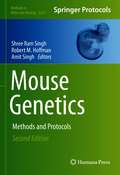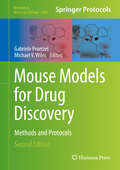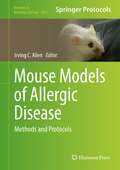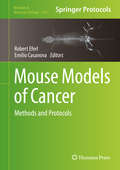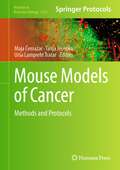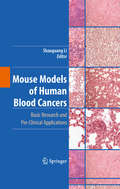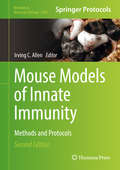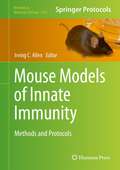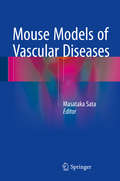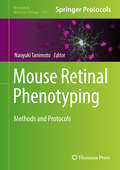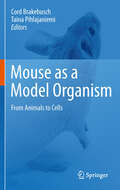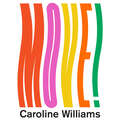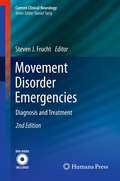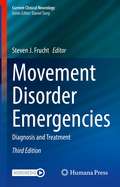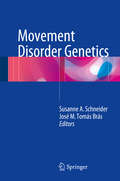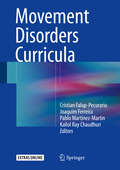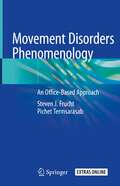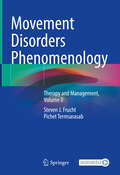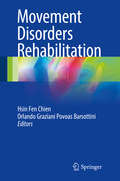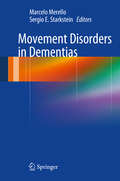- Table View
- List View
Mountain Shelter
by Cassie MilesA mountain hideaway is all that stands between a bodyguard and the killer after his beautiful client... As a highly skilled cyber security expert and bodyguard, there are few dangers Dylan Timmons can't handle. But his next assignment brings unexpected risks. Hired to protect brilliant-but socially reclusive-neurosurgeon Jayne Shackleford, Dylan seeks answers in what he suspects was a foiled kidnapping attempt. As the daughter of an oil tycoon, Jayne is the perfect target for ransom, so retreating to the mountains is the first step in keeping her safe. The second step is remaining vigilant in their secluded surroundings-and resisting the beautiful brunette with a target on her back.
Mourning Sarah
by Theresa Huttlinger Vigour‘In this astonishing read, we follow Vigour's journey into darkness and loss, a gripping pilgrimage that leads to eventual knowledge and empowerment. This lucid book should be required reading for any woman headed to the maternity ward. This unforgettable book reveals what would have happened to my son and family had he not been treated for group B strep at birth. Let's celebrate Vigour's brave testimony here and take heed of her hard-won insights on the medical establishment that surrounds the birth experience.’ Paul Morris, Director, Master of Liberal Studies Program, Arizona State University, USA ‘A tragic story, clearly told. Theresa shares the confusion, pain and devastation she and her family experienced around the time of her daughter, Sarah's, birth and early death from potentially preventable group B Strep infection. Many who have suffered similar losses will draw comfort from this book, knowing that they aren't alone. Thankfully, as Theresa outlines, measures are now in place in the US that ensure most group B strep infections in babies are prevented there – in the UK, we're yet to achieve this, though we continue to campaign for such measures to be introduced. Perhaps were the decision makers to read this book, it would happen sooner - I fervently hope so.’ Jane Plumb, Chairman, Group B Strep Support, UK ‘Mourning Sarah is filled with important, even urgent, messages for any woman having a baby right here, right now, and for all young girls who soon will grow into womanhood and want babies of their own. Theresa Vigour articulates the unspeakable loss of her daughter using every hue in the emotional rainbow. Her account is exquisite, her metaphors masterful, and throughout the book, she skilfully weaves her inner and outer worlds. Theresa Vigour has given us a gift.’ Lorraine Ash in her Foreword 'Deep was the grief that came with the death of Theresa Vigour's newborn daughter, Sarah. Yet profound is this memoir of her mother's journey. It is a gift to see such raw and visceral emotion transformed into beautiful and evocative prose that touch and teach and heal.' Walt Harrington, author of The Everlasting Stream
Mourning a Breast
by Xi XiBy Xi Xi, part of the first generation of writers raised in Hong Kong, a wise and amiably written book of autobiographical fiction on the author&’s experience with breast cancer—from diagnosis to treatment to recovery—and her passage from a life lived through the mind into a life lived through the body.In 1989, the acclaimed Hong Kong writer Xi Xi was diagnosed with breast cancer. Her semi-autobiographical novel Mourning a Breast is a disarmingly honest and inventive account of the author&’s experience of a mastectomy and of her subsequent recovery. The book opens with her putting away a bathing suit. As the routine pleasure of swimming is revoked, the small loss stands in for the greater one. But Xi Xi&’s mourning begins to take shape as a form of activism. Addressing her reader as frankly and unashamedly as an old friend, she describes what she is going through; finds consolation in art, literature, and cinema; and advocates for a universal literacy of the body. Mourning a Breast was heralded as one of the first Chinese-language books to cast off the stigma of writing about illness and to expose the myths associated with breast cancer. It is a radical novel about creating in the midst of mourning.
Mouse Development
by Jacek Z. KubiakThe mouse is a perfect model organism to study mammalian, and thus indirectly also human, embryology. Most scientific achievements that have had an important impact on the understanding of basic mechanisms governing embryo development in humans, originated from mouse embryology. Stem cell research, which now offers the promise of regenerative medicine, began with the isolation and culture of mouse embryonic stem cells by Martin Evans (who received the Nobel Prize in medicine in 2007 for this achievement) and Matthew Kaufman. This book provides an overview of mouse development, spanning from oocytes before fertilization to the state-of-the-art description of embryonic and adult stem cells. The chapters, written by the leading specialists in the field, deal with the most recent discoveries in this extremely fast-developing area of research.
Mouse Embryogenesis: Methods And Protocols (Methods In Molecular Biology #1752)
by Paul Delgado-OlguinThis volume explores protocols for identifying mutant mice and characterizing parts of their anatomical, functional, cellular, and molecular phenotypes. The chapters in this book look at anatomical and functional phenotyping using quantitative imaging, isolation of specific embryonic cell types for cell culture, analysis of gene expression, and how to define chromatin structure. Written in the highly successful Methods in Molecular Biology series format, chapters include introductions to their respective topics, lists of the necessary materials and reagents, step-by-step, readily reproducible laboratory protocols, and tips on troubleshooting and avoiding known pitfalls.Cutting-edge and authoritative, Mouse Embryogenesis: Methods and Protocols is a valuable resource for experimentalists interested in discovering new aspects of embryogenesis control, organ function, and the origin of disease.
Mouse Genetics: Methods and Protocols (Methods in Molecular Biology #2224)
by Shree Ram Singh Robert M. Hoffman Amit SinghThis fully updated edition provides selected mouse genetic techniques and their application in modeling varieties of human diseases. The chapters are mainly focused on the generation of different transgenic mice to accomplish the manipulation of genes of interest, tracing cell lineages, and modeling human diseases. Written for the highly successful Methods in Molecular Biology series, chapters include introductions to their respective topics, lists of the necessary materials and reagents, step-by-step, readily reproducible laboratory protocols, and tips on troubleshooting and avoiding known pitfalls. Authoritative and up-to-date, Mouse Genetics: Methods and Protocols, Second Edition delivers fundamental techniques and protocols to geneticists, molecular biologists, cell and developmental biologists, students, and postdoctoral fellows working in the various disciplines of genetics, developmental biology, mouse genetics, and modeling human diseases.
Mouse Models for Drug Discovery
by Gabriele Proetzel Michael V. WilesAs the drug discovery process shifts more and more toward specifically targeting pathways and molecules, model systems continue to increase in importance, and the mouse, with its versatility, ease of use, and remarkable similarity to the human genome, has clearly risen to the forefront of animal model studies. In Mouse Models for Drug Discovery: Methods and Protocols, experts in the field present some background for those less familiar with mice as experimental model platforms as well as a collection of techniques involving general methods as well as specific disease topics such as type 1 and 2 diabetes, cardiovascular disease, arthritis, skin disorders, cancer, the use of behavioral models for depression and anxiety, neurodegenerative diseases, neuromuscular diseases, and infectious diseases. Written in the highly successful Methods in Molecular BiologyTM series format, chapters include introductions to their respective topics, lists of the necessary materials and reagents, step-by-step, readily reproducible laboratory protocols, and notes on troubleshooting and avoiding known pitfalls. Authoritative and easy-to-use, Mouse Models for Drug Discovery: Methods and Protocols will stimulate those not familiar with the power of the mouse and its potential for the drug discovery process, and it will encourage the development of new models and new ways to utilize existing models in order to further the use of this dynamic animal in this vital field.
Mouse Models of Allergic Disease: Methods and Protocols
by Irving C. AllenOver the last half century, a dramatic increase in allergic diseases has been observed throughout industrialized nations, which has resulted in significant worldwide socio-economic challenges. In Mouse Models of Allergic Disease: Methods and Protocols, a wide range of expert contributors provide detailed protocols for the design and execution of experiments to thoroughly analyze critical elements associated with a diverse range of allergic diseases, all through the lens of mouse models that accurately recapitulate clinically relevant aspects of the respective human disease. The volume opens with a section featuring techniques essential for effective ex vivo cell isolation and evaluation of specific cell types relevant to a diverse range of allergic diseases, and the book then moves on to cover in vivo protocols to evaluate prevalent mouse models of human allergic diseases, including mouse models of systemic anaphylaxis, contact hypersensitivity, allergic rhinitis, and asthma, as well as a collection of chapters on in vivo and ex vivo protocols used to assess indirect mediators of allergic diseases, such as the nervous system, non-hematopoietic cells, and the composition of the gut microbiome. Written in the highly successful Methods in Molecular Biology series, chapters include introductions to their respective topics, lists of the necessary materials and reagents, step-by-step, readily reproducible laboratory protocols, and tips on troubleshooting and avoiding known pitfalls. Timely and authoritative, Mouse Models of Allergic Disease: Methods and Protocols serves as an essential collection of protocols that allow both novice and expert researchers the ability to accurately develop, evaluate, and characterize the mechanisms associated with these disorders.
Mouse Models of Cancer
by Robert Eferl Emilio CasanovaThis volume is essential for geneticists, molecular biologists, biochemists, and medical doctors interested in the use of mouse models in cancer research. Recent genome studies, together with refined genetic engineering techniques, have greatly increased the value of using mice for research on cancer and other human disorders. The chapters of this book will support scientists in choosing the most suitable mouse models for their research questions. The book provides detailed methodological information for genetic or chemical induction of different types of cancer, histomorphometric cancer analysis, and in vivo imaging, as well as protocols to investigate oncogene addiction, immune surveillance, and hallmarks of cancer such as angiogenesis or metastasis. Four review-like articles provide background information on mouse technologies and histopathologic differences between mouse and human cancers. The mouse models described in individual chapters will fuel the understanding of cancer initiation, immune system roles, tumor angiogenesis, invasion, metastasis, and the relevance of molecular diversity observed among human cancers. Written in the highly successful Methods in Molecular Biology series format, chapters include introductions to their respective topics, lists of the necessary materials and reagents, step-by-step, readily reproducible laboratory protocols, and tips on troubleshooting and avoiding known pitfalls. Cutting-edge and resourceful, Mouse Models of Cancers: Methods and Protocols, is a valuable laboratory resource for all researchers, from the graduate level upwards, who study cancer and new possibilities for its treatment.
Mouse Models of Cancer: Methods and Protocols (Methods in Molecular Biology #2773)
by Maja Čemažar Tanja Jesenko Urša Lampreht TratarThis detailed volume presents a variety of mouse models for cancer studies, from leukemia and lymphoma models to different types of subcutaneous and orthotopic models. Models for the healing process and the assessment of the immune response after local ablative therapies are also included, as well as imaging techniques that allow for the visualization of cancer at the cellular and tissue level. The book closes with a detailed description of necropsy, which is essential for obtaining good biomaterial for translational research. Written for the highly successful Methods in Molecular Biology series, chapters include introductions to their respective topics, lists of the necessary materials and reagents, step-by-step and readily reproducible laboratory protocols, and tips on troubleshooting and avoiding known pitfalls. Authoritative and practical, Mouse Models of Cancer: Methods and Protocols serves as an ideal guide to these controlled and reproducible model experimental systems to study different aspects of cancer biology, including prevention, development, progression, and treatment.
Mouse Models of Human Blood Cancers
by Shaoguang LiIn this book, Dr. Li and his author team plan to emphasize why mouse models are useful in vivo systems for understanding disease mechanisms and developing therapeutic strategies in blood cancers. The authors do not intend to cover all types of blood cancers; instead, they will focus on some major ones such as leukemias and lymphomas. However, the authors will try to cover as much as they can the cancer types and point out that many blood cancers need to be studied in mouse disease models although they are still not available at present. A major focus in the book will be to show what we can or cannot learn from mouse disease models and to also show the critical contributions of mouse models in therapeutic drug development.
Mouse Models of Innate Immunity: Methods And Protocols (Methods In Molecular Biology Series #1031)
by Irving C. AllenThis second edition presents methods and protocols to aid readers in the design and execution of experiments used to define critical elements associated with innate immune system function. New and updated chapters detail protocols on in vitro and ex vivo studies in key cell types associated with innate immunity and with in vivo protocols used to study immune system function in the mouse. Additionally, chapters describe methods to evaluate innate immune function and new protocols associated with autism, cancer, microfluidics platforms, and CRISPR systems. Written in the highly successful Methods in Molecular Biology series format, chapters include introductions to their respective topics, lists of the necessary materials and reagents, step-by-step, readily reproducible laboratory protocols, and tips on troubleshooting and avoiding known pitfalls. <P><P> Authoritative and easy to use, Mouse Models of Innate Immunity: Methods and Protocols, Second Edition will serve the research community by providing expert advice and protocols that allow both experienced and novice investigators to successfully plan, implement, and assess disease processes associated with the innate immune system.
Mouse Models of Innate Immunity: Methods and Protocols
by Irving C. AllenThe innate immune system represents a critical arm of the immune response by providing immediate and robust host defense; however, human studies of its function are often limited by ethical, logistical, and technical obstacles. In Mouse Models of Innate Immunity: Methods and Protocols, experts in the field explore the design and execution of experiments used to thoroughly evaluate critical elements associated with the host innate immune response. The volume opens with methods that are essential for collecting and assessing various primary cells that are highly relevant to innate immunity, and it continues with in vivo protocols commonly used to evaluate the innate immune response in the mouse, including mouse models of respiratory infection, gastrointestinal inflammation, fungal and parasitic diseases, sepsis, and HIV-1 infection. Written in the highly successful Methods in Molecular Biology series format, chapters include introductions to their respective topics, lists of the necessary materials and reagents, step-by-step, readily reproducible laboratory protocols, and tips on troubleshooting and avoiding known pitfalls. Authoritative and easy to use, Mouse Models of Innate Immunity: Methods and Protocols will serve the research community by providing expert advice and protocols that allow both experienced and novice investigators to successfully plan, implement, and assess disease processes associated with the innate immune response.
Mouse Models of Vascular Diseases
by Masataka SataThis book is a methodological source on mice models of vascular diseases. Covering various areas, each chapter is written by a pioneering researcher who has developed an original vascular disease model. Notoriously difficult to reproduce, each model is described in detail and numerous photographs are provided with links to videos. Genetically modified mice are a very powerful tool for studying the pathogenesis of various diseases, including immunological and oncological disorders, but they had always been thought to be too small to be used in the field of cardiovascular disease. Recently, however, various mice models of vascular diseases have been reported, and these will make a substantial contribution to basic research on cardiovascular and metabolic disorders.
Mouse Retinal Phenotyping: Methods And Protocols (Methods In Molecular Biology #1753)
by Naoyuki TanimotoThe aim of this volume is to provide a wide range of techniques and aspects of mouse retinal phenotyping and characterization. Chapters guide readers through morphological and functional properties of the mouse retina and techniques for the analysis of outer to mid-retina and mid- to inner retina. Written in the highly successful Methods in Molecular Biology series format, chapters include introductions to their respective topics, lists of the necessary materials and reagents, step-by-step, readily reproducible laboratory protocols, and tips on troubleshooting and avoiding known pitfalls. Authoritative and cutting-edge, Mouse Retinal Phenotyping: Methods and Protocols aims to ensure successful results in the further study of this vital field.
Mouse as a Model Organism
by Cord Brakebusch Taina PihlajaniemiCell culture based research is important for our understanding of biological processes at the cellular and molecular level. Using this approach, the previous decades have produced a wealth of mechanistic information in all areas of biomedical research. Such in vitro research, however, lacks the complexity of in vivo investigations, where many different cell types interact with each other in a normal, three-dimensional environment, with normal levels of cytokines and growth factors. Furthermore, complex human diseases, such as cancer, diabetes or chronic inflammation, can only be modeled in vivo. Due to its small size, its short reproduction time, and the possibility to introduce specific gene mutations, the mouse has become the favourite mammalian model organism to study in vivo function of genes during development and in disease. This book combines review articles on selected subjects presented at the symposium "Mouse as a Model Organism - From Animals to Cells", held in Rovaniemi, Finland, 2009. Among other topics, high-throughput phenotyping of mouse mutants, mouse phenotypes dependent on nature and nuture, and a spectrum of in vivo, ex vivo and in vitro methods to study cancer in mice are described. This book will give an excellent introduction to scientists interested in the use of mice as a model to understand complex biological questions in the post-genomic era. It will highlight the possibilities, but also discuss the current problems and shortcomings, to give a realistic view of the current state-of-art in this fascinating field of biomedical research.
Move!: The New Science of Body Over Mind
by Caroline WilliamsDid you know that walking can improve your cognitive skills? That strengthening your muscular core reduces anxiety? That light stretching can combat a whole host of mental and bodily ailments, from stress to inflammation? We all know that exercise changes the way you think and feel. But scientists are just starting to discover exactly how it works.In Move!, Caroline Williams explores the emerging science of how movement opens up a hotline to our minds. Interviewing researchers and practitioners around the world, she reveals how you can work your body to improve your mind. As lockdown throws us back on our own mental and physical resources, there is no better time to take control of how you think and feel.
Movement Disorder Emergencies
by Steven J. FruchtUpdated and expanded with nine additional chapters, Movement Disorder Emergencies: Diagnosis and Treatment, Second Edition is an indispensable resource for general neurologists, specialists, fellows, and residents eager to improve their approach toward the patient with a movement disorder emergency. In this comprehensive second edition, prominent neurologists from around the world logically and systematically review the major movement disorder emergencies, instructing the reader on how optimally to recognize and manage these problems. The authors cover a broad range of disorders, including acute dystonic reactions, neuroleptic malignant syndrome, startle syndromes, tic emergencies, and others; and they stress the importance of certain obvious diagnoses such as Wilson's disease, dopa-responsive dystonia, and Whipple's disease, in which delayed diagnosis in less emergent situations can lead to slowly evolving and often irreversible neurologic damage with tragic consequences. In addition, nine topics not covered in the first edition are provided, including genetic counseling and testing crises, suicide risk, psychogenic movement disorders, and others. Patient vignettes at the beginning of each chapter focus the reader's attention and highlight the urgency of the problem. Since astute clinical diagnosis of many movement disorders is still largely dependent on visual pattern recognition in the clinic, an accompanying online collection of physician-patient vignettes illustrates virtually all of the movement disorders described in the text. Importantly, the authors also discuss a range of new treatment paradigms that have emerged since publication of the first edition, especially deep brain stimulation. Authoritative and a leading text in the field, Movement Disorder Emergencies: Diagnosis and Treatment, Second Edition is an established, practical reference that continues to achieve excellence in the field of diagnosis and management of movement disorder emergencies.
Movement Disorder Emergencies: Diagnosis and Treatment (Current Clinical Neurology)
by Steven J. FruchtThis book logically and systematically reviews the major movement disorder emergencies. It instructs the reader on how to recognize and manage these problems. This updated new edition of Movement Disorder Emergencies consists of five comprehensive sections. It begins with chapters that relay the various practical approaches one can administer when treating a patient with a movement disorder emergency. Section two then delves into specific hyperacute movement disorder emergencies such as acute parkinsonism, serotonin syndrome, and malignant catatonia. Following this, section three examines various acute movement disorder emergencies, including tic emergencies and Sydenham’s chorea. Sections four and five explore issues that can occur during treatment, such as pitfalls in diagnosis and risks in the clinic. Written by prominent neurologists from around the world, Movement Disorder Emergencies, 3rd edition is a practical reference that achieves excellence in diagnosis and management of movement disorder emergencies.
Movement Disorder Genetics
by Susanne A. Schneider José M. Tomás BrásThis book covers recent developments and possible pitfalls in the diagnosis of genetic movement disorders and related conditions. It is divided into three sections: technical and scientific aspects; clinical aspects with guidance towards work-up; and ethical and legal aspects of genetic testing in a clinical and research setting. The first section includes chapters on genetic analysis and counselling with critical discussion of potential problems when interpreting the results. Clinical chapters summarize genetic forms of movement disorders including parkinsonism, tics and dystonia with algorithms for hands-on daily practice. Related conditions such as RLS, ataxias and dementias are also covered. Finally, chapters on ethical and legal aspects of genetic testing are included. Movement Disorder Genetics is aimed at clinicians and scientists working in the field of movement disorders and related conditions.
Movement Disorders Curricula
by Joaquim Ferreira Cristian Falup-Pecurariu Pablo Martinez-Martin Kallol Ray ChaudhuriThis book offers a comprehensive approach to the wide range of movement disorders, an important specialty in the field of neurology, guiding readers from the phenomenology to diagnosis and management. Reflecting the latest developments in the field, it offers a unique summary of this dynamic area by pursuing a uniform approach to movement disorders curricula. Divided into three parts, Movement Disorders Curricula provides an authoritative overview of this growing branch of neurology. The first part presents the basic elements of movement disorders, including descriptions of the anatomy and physiology of the basal ganglia. It also features sections on clinical trials for movement disorders, practical skills, and rating scales. The second and third part examine in detail hypokinetic and hyperkinetic movement disorders, respectively. Equipping readers with the practical and research skills needed in the movement disorders field, the book offers a valuable tool to help them prepare for board examinations on general neurology, as well as for fellowships in movement disorders.
Movement Disorders Phenomenology: An Office-Based Approach
by Steven J. Frucht Pichet TermsarasabThis book presents a comprehensive, practical approach to the evaluation of movement disorders using phenomenological basic principles, new discoveries in phenomenological research, and core values of outpatient neurology.Movement Disorders Phenomenology begins with an overview of phenomenology and common approaches to movement disorder patients. Subsequent chapters then accurately and concisely relay information on major hypokinetic disorders such as atypical Parkinsonism, idiopathic Parkinson’s disease, cortical myoclonus, and complex motor tics. Expertly written text is further supplemented by patient vignettes at the beginning of select chapter that focus the reader's attention and highlight the urgency of the problem. These high quality videos aid in the astute clinical diagnosis of many movement disorders that are still largely dependent on visual pattern recognition in the clinic. The book closes with a timely discussion on the role of genetics in movement disorders.Written for the practicing physician, Movement Disorders Phenomenology is an indispensable reference for neurology residents, general neurologists, movement disorders fellows and clinicians, and to any clinician who encounters and evaluates patients in the outpatient arena.
Movement Disorders Phenomenology: Therapy and Management, Volume II
by Steven J. Frucht Pichet TermsarasabThis practical, case-based book offers an approach to diagnosis and treatment of movement disorders in the outpatient setting. The major hypokinetic and hyperkinetic disorders are considered in turn, with more than 1,000 videos illustrating the role of phenomenology in the diagnosis and treatment of these conditions. Discussion of the role of ancillary testing (imaging, genetic testing) and treatment options with medications, botulinum toxin injections, and surgical intervention are woven in to the discussion of cases throughout the book. Special attention is directed to pitfalls and perils of office-based practice. This volume will be of interest to movement disorders neurologists and trainees, general neurologists, neurology residents, and any healthcare professional with an interest in exploring the application of the many treatments that have transformed movement disorders into a therapeutic field. Rather than a textbook of movement disorders, thisvolume will help the practicing clinician in guiding the thought process for evaluation and management of patients in the clinic.
Movement Disorders Rehabilitation
by Hsin Fen Chien Orlando Graziani Povoas BarsottiniThe aim of this book is to provide a comprehensive overview of the most important movement disorders and describe the rehabilitation tools available for each disease. The management of movement disorders is challenging since most of these diseases are not curable and hardly treatable. Many of the disorders are chronic or degenerative diseases, therefore patients develop motor complications that could improve with rehabilitation interventions. Movement Disorders Rehabilitation intends to serve as a practical guide on the field, attracting the interest of professionals and researchers on the fields of neurology, physical therapy, occupational therapy, speech therapy and other correlated therapies.
Movement Disorders in Dementias
by Marcelo Merello Sergio E. StarksteinThis book focuses on extrapyramidal signs and symptoms of all types of dementia, and addresses the issue of the artificial boundary between dementias and Parkinsonism, which represent the two most common symptoms found in degenerative central nervous system diseases. In Movement Disorders in Dementias, movement disorder specialists from around the world write on topics generally restricted to dementia experts. Important motor issues related to either medication in demented patients (drug-induced movement disorders) or manifestations common to all forms of dementia, regardless of underlying cause (gait disorders, falls, fear of falling), is followed by analysis of the relationship between motor and cognitive symptoms, from their common pathogenesis to specific medical treatments. Movement Disorders in Dementias is aimed at general neurologists, dementia specialists, movement disorders specialists, neuropsychologists and geriatricians.

